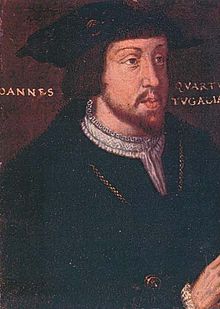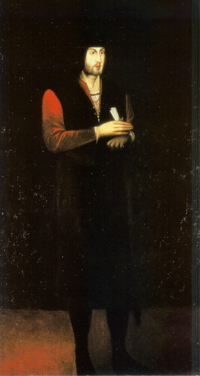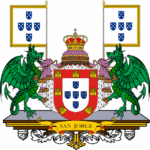- John II of Portugal
-
John II 
King Dom João II (John II) King of Portugal and the Algarves Reign 11 November 1477–15 November 1477 (4 days) Predecessor Afonso V Successor Afonso V King of Portugal and the Algarves
(second time)Reign 28 August 1481—25 October 1495 (14 years, 58 days) Predecessor Afonso V Successor Manuel I Spouse Eleanor of Viseu Issue Afonso, Prince of Portugal Father Afonso V of Portugal Mother Isabella of Coimbra Born 3 March 1455
Alcáçovas Palace, Castle of São Jorge, Lisbon, Kingdom of PortugalDied 25 October 1495 (aged 40)
Alvor, Portimão, Kingdom of AlgarveBurial Monastery of Batalha, Batalha, District of Leiria, Portugal Portuguese royalty
House of AvisJohn I Children Edward I Peter, Duke of Coimbra Henry the Navigator Isabella, Duchess of Burgundy John, Lord of Reguengos de Monsaraz Ferdinand the Saint Prince Grandchildren include Isabella, Queen of Portugal Edward Children Afonso V Ferdinand, Duke of Viseu Eleanor, Holy Roman Empress Catherine Joan, Queen of Castile Grandchildren include Manuel I Eleanor, Queen of Portugal Isabella, Duchess of Braganza Great-Grandchildren include James, Duke of Braganza, Prince of Portugal Afonso V Children include John, Prince of Portugal Joan, Princess of Portugal John II John II Afonso, Prince of Portugal John II (Portuguese pronunciation: [ʒuˈɐ̃w̃]; Portuguese: João II) (3 March 1455–25 October 1495), the Perfect Prince (Port. o Príncipe Perfeito), was the thirteenth king of Portugal and the Algarves. He is known for re-establishing the power of the Portuguese throne, reinvigorating its economy, and renewing its exploration of Africa and the Orient.
Contents
Early life
Born in Lisbon, the son of King Afonso V of Portugal by his wife, Isabella of Coimbra, princess of Portugal, John II succeeded his father in 1477 when the king retired to a monastery, but only became king in 1481, after the death of his father and predecessor.
As a prince, John II accompanied his father in the campaigns in northern Africa and was made a knight after the victory in the Conquest of Arzila in 1471. In 1473, he married Leonor of Viseu, Infanta of Portugal and his first cousin.
Even at a young age, John was not popular among the peers of the kingdom since he was immune to external influence and appeared to despise intrigue. The nobles (including particularly Ferdinand II, the Duke of Braganza), were afraid of his future policies as king.
Consolidation of Power
After his official accession to the throne in 1481, John II took a series of measures to curtail the overgrown power of his aristocracy and to concentrate power in himself. Immediately, the nobles started to conspire. Letters of complaint and pleas to intervene were exchanged between the Duke of Braganza and Queen Isabella I of Castile. In 1483, this correspondence was intercepted by royal spies. The House of Braganza was outlawed, their lands confiscated and the duke executed in Évora.
In the following year, the Duke of Viseu, John's cousin and brother-in-law, was summoned to the palace and stabbed to death by the king himself for suspicion of a new conspiracy. Many other people were executed, murdered, or exiled to Castile including the bishop of Évora who was poisoned in prison.
Concerning the rebellious nobles, the king is reported to have said, "I'm the lord of lords, not the server of servants"[citation needed]. Following the crackdown, no one in the country dared to defy the king and John saw no further conspiracies during his reign. The nobles who sided with John II or surrendered were forced to make public pledges of loyalty; in return they were given certain privileges, yet they still had to pay taxes.
Economy
Facing a bankrupt kingdom, John II showed the initiative to solve the situation by creating an agile regime in which the Council of Scholars took a vital role. The king then conducted a search of the population and selected members of the Council according to their abilities, talents and credentials. Popular complaints on judicial acts normally had the sympathy of the king. John's exploration policies (see below) also paid great dividends. Even before the Tordesilhas Treaty, such was the profit coming from John II's investments in the overseas explorations and expansion that the Portuguese currency had become the soundest in Europe. The kingdom could finally collect taxes on its own as all of its debts had been paid off, mainly thanks to its main gold source at that time, the coast of Guinea.
Exploration
John II famously restored the policies of Atlantic exploration, reviving the work of his great-uncle, Henry the Navigator. The Portuguese explorations were his main priority in government, pushing south the known coast of Africa with the purpose of discovering the maritime route to India. During his reign, the following achievements were realized:
- 1482 - Foundation of the coastal fortress and trade post of São Jorge da Mina ( Elmina ).
- 1484 – Discovery of the Congo River by Diogo Cão
- 1488 - Arrival of Bartolomeu Dias in Mossel Bay[1]
- 1493 – Start of the settlement of the São Tomé and Príncipe islands by Álvaro Caminha
- Funding of land expeditions by Afonso de Paiva and Pêro da Covilhã to India and Ethiopia in search of Prester John land.
Some historians[who?] argue about the real extent of Portuguese voyages of exploration during this period, claiming the king had a secrecy policy. According to this theory some navigations were kept secret for fear of competition by neighbouring Castile. The archives of this period were destroyed in the fire after the 1755 Lisbon earthquake, and what was not destroyed during the earthquake was either stolen or destroyed during the Peninsular War or otherwise lost. Their true extent has long been the subject of academic debate.[2][3][4]
Conflict with Castile
When Columbus returned from his voyage he thought of first stopping in Lisbon to claim his victory in front of King John II. King John II's only response to this was that under the Treaty of Alcáçovas previously signed with Spain, Columbus's discoveries lay within Portugal's sphere of influence. Before Columbus even reached Isabella I of Castile, John II had already sent a letter to them threatening to send a fleet to claim it for Portugal. Spain quickly hastened to the negotiating table which took place in a small town near the Portuguese border named Tordesillas. There was also a papal representative during that occasion in order to act as mediator. The result of this would be the famous Treaty of Tordesillas.
But the division of the world was not the main issue between the Iberian kingdoms. Isabella I of Castile and Ferdinand II of Aragon had several daughters, but only one feeble male heir — Juan. The oldest daughter, Isabella of Aragon, had been married to Afonso, Prince of Portugal, since childhood. Afonso was John II's only son and beloved by the king. If Juan died without male heir, as was probable, Afonso would be heir not only of Portugal, but also of Castile and Aragon. This threat to Castilian and Aragonese independence was very real, and the Catholic Monarchs tried every diplomatic trick to dissolve the wedding. Finally, in 1491, Afonso died in mysterious circumstances — a fall from a horse during a ride in the margin of the Tagus river. The influence of the Catholic Monarchs in this accident was never proved, but the prince was an excellent rider, his Castilian valet fled never to be seen again, and after this, Isabella, the heiress, was no longer married to the enemy. John tried without success until the end of his life to legitimise Jorge, Duke of Coimbra, his illegitimate son.
Legacy
John II died at Alvor without leaving a male heir apparent, aged only 40 years old. He was succeeded by his first cousin Manuel I.
The nickname the Perfect Prince is a late description and refers to Niccolò Machiavelli's work The Prince. John II is considered to have lived his life exactly according to the writer's idea of a perfect prince. Nevertheless, he was admired as one of the greatest European monarchs of his time. Isabella I of Castile usually referred to him as El Hombre (The Man).
In popular culture
- In the TV series Christopher Columbus (1985) he was played by Max von Sydow.
- He appears in Civilization IV (as João II), leading the Portuguese.
References
- ^ Disney, A.R. (2009) A History of Portugal and the Portugal Empire, Volume 2: The Potuguese Empire: 38-39; Cambridge University Press: New York
- ^ Charles E. Nowell (1936). "The Discovery of Brazil: Accidental or Intentional?". The Hispanic American Historical Review 16 (3): 311–338. http://www.jstor.org/stable/2507557. Retrieved 17 November 2010.
- ^ J. Baltalha-Reis (1897). "The Supposed Discovery of South America before 1488, and Critical Methods of the Historians of Geographical Discovery". The Geographical Journal 9 (2): 185–210. http://www.jstor.org/stable/1773506. Retrieved 17 November 2010.
- ^ Ilaria Luzzana Caraci (1988). Columbus and the Portuguese Voyages in the Columbian Sources. UC Biblioteca Geral 1. http://books.google.com/books?hl=en&lr=&id=EwSy2jB--boC&oi=fnd&pg=PA561&dq=%22joao+II%22+portugal+America&ots=u9yhly1zVu&sig=HXsnAOGlJIMlByUiB5TMCfzbwfM#v=onepage&q&f=false. Retrieved 17 November 2010.
- Page, Martin The First Global Village
- Boxer, Charles R. From Lisbon to Goa, 1500–1750 (1991)
- Boxer, Charles R. The Portuguese Seaborne Empire 1415–1825
- Mira, Manuel S. Forgotten Portuguese: The Melungeons and the Portuguese Making of America (1998)
- Duffy, James Portuguese Africa (1968)
- Bodian, Mirian Hebrews of the Portuguese Nation (1997)
Ancestry
Ancestors of John II of Portugal 16. Peter I of Portugal (=#24) 8. John I of Portugal (=#12) 17. Teresa Lourenço (=#25) 4. Edward I of Portugal 18. John of Gaunt, 1st Duke of Lancaster (=#26) 9. Philippa of Lancaster (=#13) 19. Blanche of Lancaster (=#27) 2. Afonso V of Portugal 20. John I of Castile 10. Ferdinand I of Aragon 21. Eleanor of Aragon 5. Eleanor of Aragon 22. Sancho Alfonso, 1st Count of Alburquerque 11. Eleanor of Alburquerque 23. Infanta Beatrice of Portugal 1. John II of Portugal 24. Peter I of Portugal (=#16) 12. John I of Portugal (=#8) 25. Teresa Lourenço (=#17) 6. Infante Peter, Duke of Coimbra 26. John of Gaunt, 1st Duke of Lancaster (=#18) 13. Philippa of Lancaster (=#9) 27. Blanche of Lancaster (=#19) 3. Isabella of Coimbra 28. Peter II, Count of Urgell 14. James II, Count of Urgell 29. Margherita of Montferrat 7. Isabella of Urgell 30. Peter IV of Aragon 15. Isabella of Aragon 31. Sibila of Fortia Marriage and descendants
Of his wife, Leonor of Viseu, Infanta of Portugal John had two sons, but only one of them survived childhood.
Name Birth Death Notes By Leonor of Viseu ( 2 May 1458 – 17 November 1525; married in January 1471) Infante Afonso 18 May 1475 13 July 1491 Prince of Portugal. Died in a horse riding accident. Because of the premature death of the prince the throne was inherited by Manuel of Viseu, Duke of Beja, son of Ferdinand, Duke of Viseu, who reigned as Manuel I, 14th King of Portugal. Infante João (John) 1483 1483 By Ana de Mendonça (c. 1460-?) Jorge 21 August 1481 22 July 1550 Natural son known as Jorge de Lencastre. Duke of Coimbra. By Brites Anes (c. 1460-?) Brites Anes de Santarém c. 1485 ? Natural daughter. John II of PortugalCadet branch of the House of BurgundyBorn: 3 March 1455 Died: 25 October 1495Regnal titles Preceded by
Afonso VKing of Portugal and the Algarves
1477–1477Succeeded by
Afonso VKing of Portugal and the Algarves
1481–1495Succeeded by
Manuel IPortuguese royalty Preceded by
JoanaPrince of Portugal
1455–1477Succeeded by
AfonsoPreceded by
AfonsoPrince of Portugal
1477–1481Infantes of Portugal The generations indicate descent form Afonso I, and continues through the House of Aviz, the House of Bourbon through Isabella of Portugal, and the House of Braganza through Infanta Catherine, Duchess of Braganza.1st Generation 2nd Generation Infante Raimundo • Afonso II • Infante Pedro, Count of Urgell • Infante Fernando, Count of Flanders • Infante Henrique3rd Generation 4th Generation 5th Generation Infante Afonso, Lord of Leiria • Afonso IV6th Generation 7th Generation Infante Luís • Ferdinand I • Infante Afonso • Infante João, Duke of Valencia de Campos • Infante Dinis, Lord of Cifuentes8th Generation Infante Pedro • Infante Afonso • Infante Afonso • Edward I • Infante Pedro, 1st Duke of Coimbra • Infante Henrique, 1st Duke of Viseu • Infante João, Lord of Reguengos de Monsaraz • Infante Fernando, the Saint Prince9th Generation Infante Miguel^ • Infante Diogo, Constable of Portugal • Infante João • Peter V, King of Aragon • Infante João, Prince of Antioch • Afonso V • Cardinal-Infante Jaime • Infante Fernando, 2nd Duke of Viseu • Infante Duarte10th Generation Infante João, 3rd Duke of Viseu • Infante Diogo, 4th Duke of Viseu • João, Prince of Portugal • John II • Infante Duarte • Infante Diniz • Infante Simião • Infante Afonso • Manuel I11th Generation Afonso, Prince of Portugal • Infante João • Miguel da Paz, Prince of Portugal and Asturias^ • John III • Infante Luís, 5th Duke of Beja • Infante Fernando, Duke of Guarda and Trancoso • Cardinal-Infante Afonso • Henry, The Cardinal-King • Infante Duarte, 4th Duke of Guimarães • Infante António • Infante Carlos12th Generation Afonso, Prince of Portugal • Manuel, Prince of Portugal • Filipe, Prince of Portugal • Infante Dinis • John Manuel, Prince of Portugal • Infante António13th Generation 14th Generation 15th Generation Balthasar Charles, Prince of Portugal and Asturias* • Infante Francisco Fernando* • Teodósio, 1st Prince of Brazil • Afonso VI • Peter II16th Generation João, 3rd Prince of Brazil • John V • Infante Francisco, 7th Duke of Beja • Infante António • Infante Manuel, Count of Ourém •17th Generation 18th Generation none19th Generation 20th Generation Francisco António, 8th Prince of Beira • Peter I of Brazil & IV of Portugal • Miguel I • Infante Pedro Carlos* • Infante Carlos José Antonio*21st Generation 22nd Generation Pedro V • Luís I • Infante João, 8th Duke of Beja • Infante Fernando • Infante Augusto, 3rd Duke of Coimbra • Infante Leopoldo • Infante Eugénio Maria • Infante Miguel, 6th Duke of Viseu • Infante Francisco José • Infante Duarte Nuno, 25th Duke of Braganza23rd Generation Carlos I • Afonso, Prince Royal and 3rd Duke of Porto • Infante Duarte Pio, Duke of Braganza • Infante Miguel, Duke of Viseu • Infante Henrique, Duke of Coimbra24th Generation Luís Filipe, Prince Royal • Manuel II • Infante Dinis, Duke of Porto • Infante Afonso, Prince of Beira •^also an infante of Castile and León, Aragon, Sicily and Naples, *also an infante of Spain, **claimant infante, ^^only prince or infante by marriageCategories:- Portuguese monarchs
- Roman Catholic monarchs
- House of Aviz
- Knights of the Garter
- Portuguese maritime history
- 1455 births
- 1495 deaths
- Princes of Portugal
- Portuguese infantes
Wikimedia Foundation. 2010.



